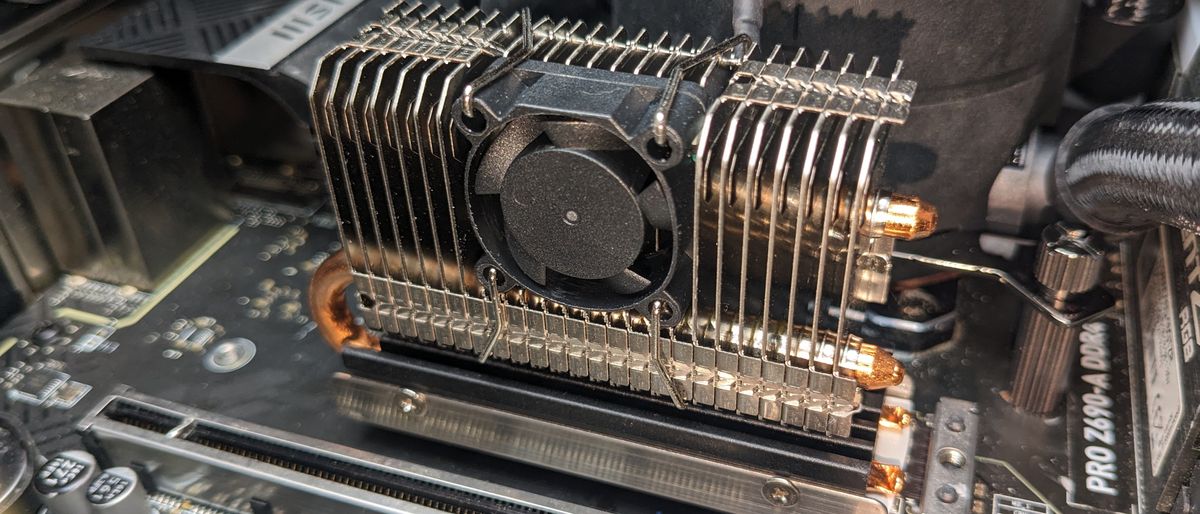Tom's Hardware Verdict
Graugear’s SSD heatsink is a strong performer, but is more expensive than many competitors.
Pros
- +
Strong thermal performance
- +
Dual-sided SSD support
- +
Two Copper Heatpipes and active fan
Cons
- -
More expensive than competitors at $29.95 USD
Why you can trust Tom's Hardware
The latest NVMe SSD cooler to land on our testbed is the G-M2HP04-F (isn’t that a mouthful?) from German manufacturer Graugear. If you’re not familiar, Graugear specializes in niche storage peripherals like thefunky Playstation 5 SSD cooler which takes advantage of that console’s CPU fan. Also included in its lineup are a variety of internal and external storage adapters, USB hubs, and other types of SSD coolers and heatsinks.
What sets the G-M2HP04-F apart from the competition? Two copper heatpipes, aluminum fins, and a fan for active cooling. Is this enough to become one of our recommended SSD coolers and heatsinks? Let’s take a dive into the specifications and features of this unit, then we’ll go over its thermal performance and our recommendation.
Cooler specifications
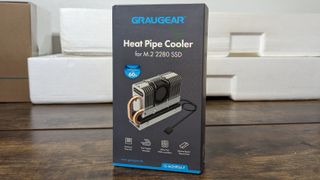
| Cooler | iHTP M.2 SSD Cooler |
| MSRP | $29.95 USD |
| Radiator Material | Aluminum fins |
| Heatpipes | Two 5mm copper heatpipes |
| Fan Speed | Up to 8500RPM |
| Fan size | 25 mm x 25 mm x 10 mm |
| Air flow | 2.87 CFM |
| Lighting | None |
| Warranty | Two years |
Packing and included contents
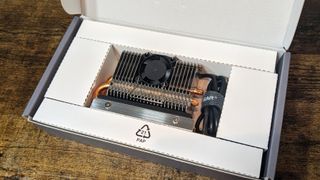
The packaging is fairly simple, with the cooler arriving in a small box just large enough to contain the product. Included in the box is the heatsink and fan, the base, two sets of thermal pads, a screwdriver, and documentation.
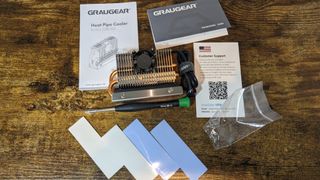
Features of Graugear’s G-M2HP04-F
▶️ Two copper heatpipes
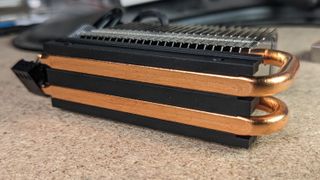
The first thing that sets Graugear’s heatsink apart from the competition is its incorporation of two 5mm copper heatpipes.
▶️ Aluminum fins, like a mini CPU cooler
The copper heatpipes of the SSD cooler connect to aluminum fins, much like a mini CPU cooler. In fact, with a little bit of tinkering, one could adapt this product to cool a low-power CPU!
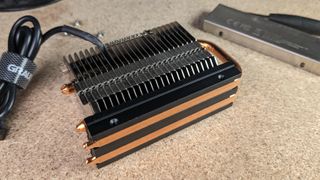
▶️ Active 25mm fan
But heatpipes and aluminum fins aren’t the only tools this Graugear SSD heatsink uses to keep your drive cool – it also features a small 25mm fan to push heat away from your NVMe drive.
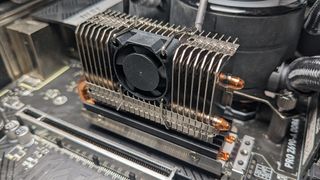
Testing configuration and methodology – LGA1700 platform
Today’s review will be the last of a heatsink tested on my last-generation platform, which was limited to PCI- 4.0 speeds. To test the effectiveness of a SSD heatsink or cooler, I run a custom IOMeter script that stresses both the SSD’s controller and NAND. The SSD heatsink is installed in the M.2 slot next to the CPU, which is cooled by an AIO.
Cooling an SSD on a PCIe 5.0 system can be more difficult, and whether your CPU is cooled by an AIO or air cooler can impact the performance of SSD heatsinks. To see how this might impact results, I encourage you to visit my recent review of iHTP’s SSD heatsink – which features testing on a modern Arrow Lake platform that supports PCIe 5.0 speeds, and has tests performed with both an air cooler and AIO cooler.
Please keep in mind that if you’re wondering if you need an aftermarket SSD heatsink at all, the answer is likely “no.” These types of devices will be most useful for those users who have storage and IO-intensive workloads in an environment with a high ambient temperature, like servers. For most common users, the benefit of a stronger SSD heatsink will be limited to increasing the longevity of your SSD.
| CPU | Intel Core i7-13700K |
| Motherboard | MSI Z690 A Pro DDR4 |
| SSD | TeamGroup Z540 |
| Case | Be Quiet! Silent Base 802, system fans set to speed 1 setting. |
| PSU | Cooler Master XG Plus 850 Platinum PSU |
| Testing Method | Custom IOMeter Script, 30 minute test length |
Heatsink Installation
The installation of an SSD heatisnk is simple, and if you’ve seen one you’ve basically seen them all. There’s very little variance in installation procedures, due to the similarities of these units.
1. Take the base of the unit and apply the first thermal pad. Then place the SSD on top of the first thermal pad.
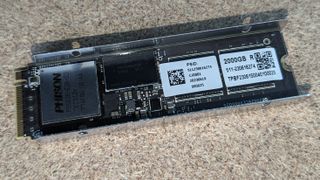
2. Place the second thermal pad atop the SSD.
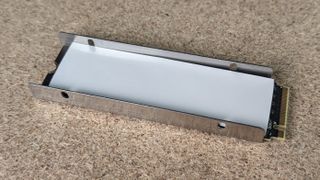
3. Place the heatsink above the top thermal pad, and then secure it with the included screws.
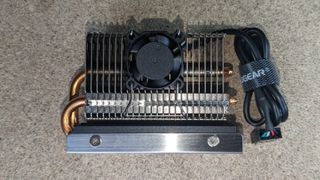
4. Finally, place the unit into an M.2 slot on your motherboard and then connect the PWM cable. I’ve installed this unit in the slot between my GPU and CPU cooler, but you may need to use another slot if you have a particularly wide air cooler.


Albert Thomas is a contributor for Tom’s Hardware, primarily covering CPU cooling reviews.
-
Marlin1975 If my hard-drive requires that much maybe I should buy another brand.Reply
I am in the process of building a new computer. Heat/power from the NVME was one of the reasons I choose 1 drive over others. -
Alvar "Miles" Udell ReplyMost users will never encounter a workload this stressful.
Articles like this make me think of the hard drive cooler craze of the early to mid 2000s. -
palladin9479 Yeah .... if your NVME needs this kind of cooling solution then something is wrong.Reply
I suspect this is due to PCIe 5 implementations using the same older fabrication process's that PCIe 3 and 4 drives used to keep costs down. Pumping up the clock rate that high causes the energy usage to spike and therefor needs active cooling. -
thestryker I kind of love the overkill solutions like this despite them not really being necessary. This seems like a rather well designed cooler which is reflected in the price.Reply
Every once in a while something will make me think about what could have been with BTX. While it was designed to maximize CPU cooling if the memory trace routing issues could have been worked around it would have been a significantly better form factor for today's systems.
Most, if not all, of the SSD heat issues are really due to the M.2 format and where these drives are located due to it. The highest power consumption I think I've seen on one of the SSD reviews here was a bit under 14W peak, but with average around 8W. These aren't exactly high numbers (compared to other desktop PC components), but when located between the CPU and GPU in an area with little airflow it becomes a problem. I would bet that most SSD heatsinks would be able to cool even the hottest drives with some form of direct airflow. -
PiersPlowman Reply
These are outrageous numbers for power consumption - worse than a 7,200 RPM HDD - if you disregard spin-up power draw.thestryker said:The highest power consumption I think I've seen on one of the SSD reviews here was a bit under 14W peak, but with average around 8W. These aren't exactly high numbers (compared to other desktop PC components)... -
thestryker Reply
While I purposely picked the worst SSD I'd seen so it's bad compared to other SSDs this is a really stupid comparison. First of all unless you set your HDDs to stop spinning when not in use pretty much all client SSDs use less power (most use a lot less) at idle. Also the SSD in question is over 20 times faster than the fastest HDD Tom's has tested (which also averages almost 8W in the copy test). Then there's the peak power consumption where almost every HDD uses more than 14W.PiersPlowman said:These are outrageous numbers for power consumption - worse than a 7,200 RPM HDD - if you disregard spin-up power draw. -
PiersPlowman Reply
No it is not. In terms of pure power consumption, the example you provide is comparable.thestryker said:While I purposely picked the worst SSD I'd seen so it's bad compared to other SSDs this is a really stupid comparison. -
thestryker Reply
Oh so you're just ignoring the significant performance difference which makes SSDs way more efficient, got it.PiersPlowman said:No it is not. In terms of pure power consumption, the example you provide is comparable. -
helper800 Reply
Exactly. If the SSD does the work 20 times faster at the same wattage as another storage device that means it also uses just 1/20th the power for the same work.thestryker said:Oh so you're just ignoring the significant performance difference which makes SSDs way more efficient, got it.
